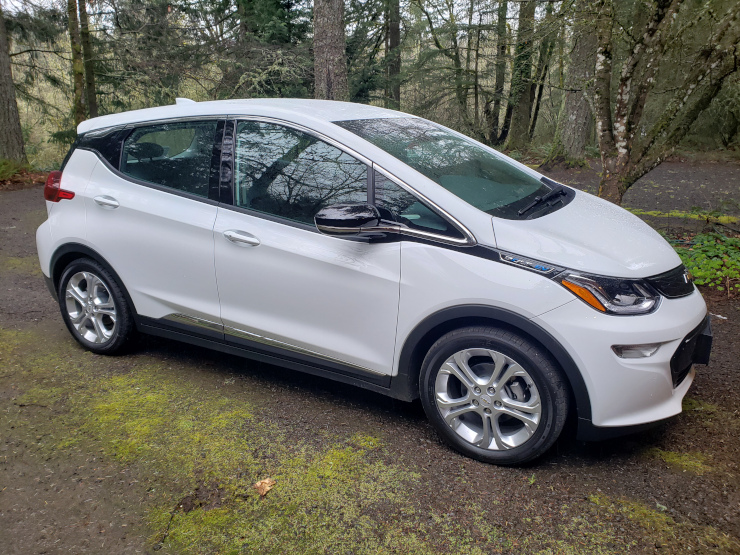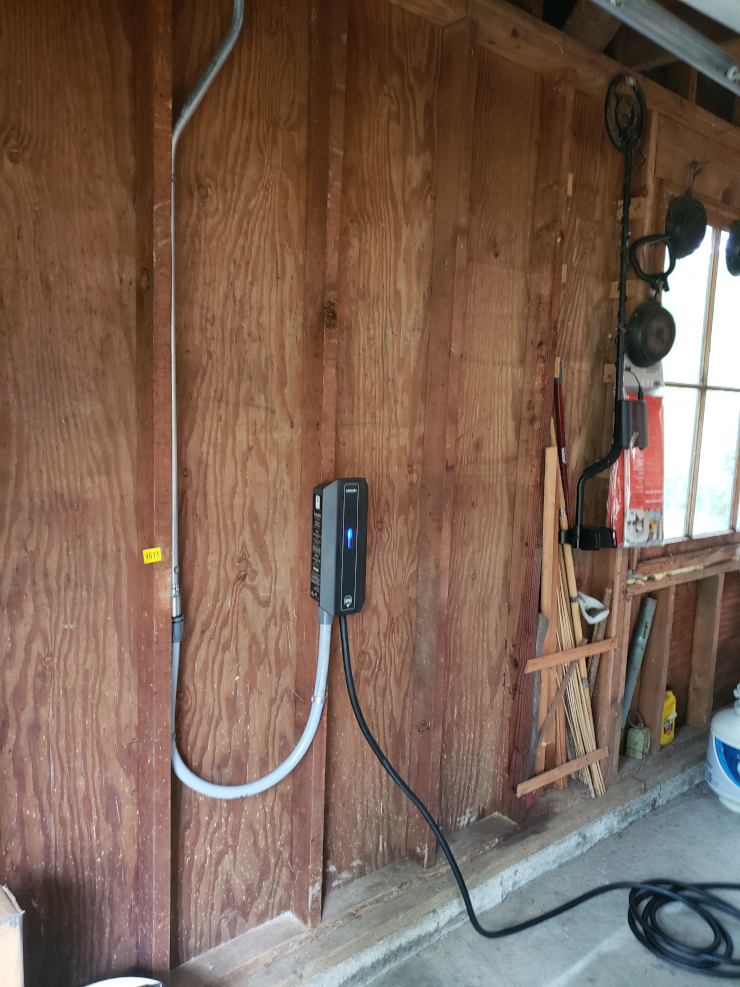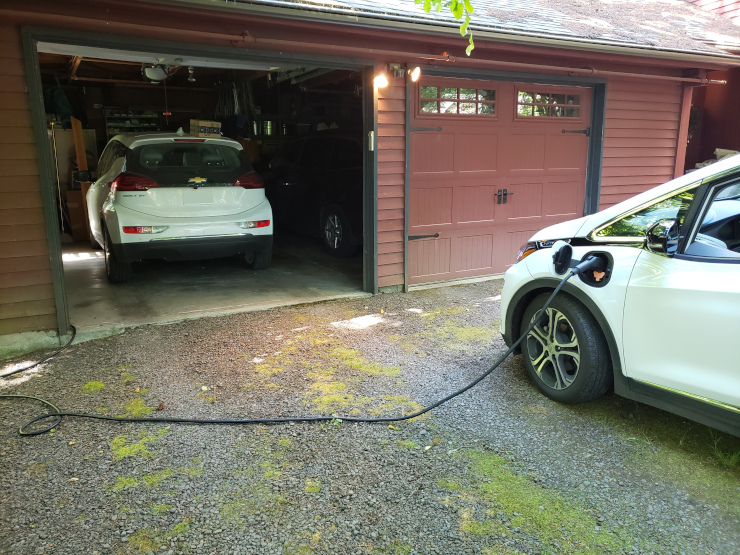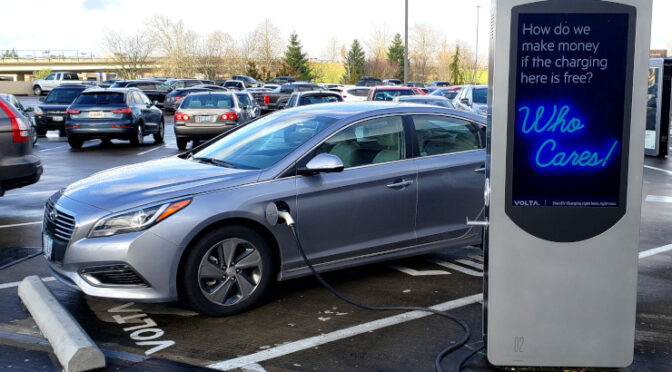In January 2020 I started shopping for an electric car, buying a 2020 Chevy Bolt at the end of March. This post is a summary of the resources and methods I used to choose that car among the – happily – several likely electric cars on the market.
Years ago when I bought my 2004 Honda Civic Hybrid, I wanted an electric car, but it wasn’t quite their time yet. Happily, today there are several affordable, long-range electric cars and loads of charging stations around the USA – it’s time!
Our Lifestyle
- We have two cars: a road trip car and a commuter car: a Honda Odsyssey and a 2004 Honda Civic Hybrid. We wanted to replace the Hybrid with a fully-electric car.
- We think of our cars as – mostly – functional things. We tend to drive a car until it gives up rather than trading it in after a couple years.
- We prefer car models that have been around for one or two years so the initial manufacturing kinks have been worked out .
- We want an electric car to reduce our carbon footprint, rather than specifically to save money over a gas car (although it does that).
I started by looking at how I drive: I used my Civic for shopping, etc., around town. Before I retired I used it as my commuter car. Linda is a novelist, with her office at home. For family trips we (Linda, our dogs Pippa and Winnie, and I) pile into our traditional road trip car.
To get an idea of what driving range I needed, for the past couple years I’ve been noting my short trip mileage: the distance I traveled each day. I found I often do 40 miles in a day, with a maximum of about 80 miles in a day. There are other days when both of us stay home.
Finding a Match to Our Lifestyle
Armed with those numbers, I went to the Sierra Club Electric Vehicle Guide, which has a quick survey that let me narrow the quite large field of electric cars down to something like 11 car models that fit our lifestyle (passenger and cargo space, at home charging, miles of range).
Of that initial set of cars, I eliminated ones that weren’t nationally available (a test of the maturity of the car model), and eliminated those from manufacturers I’d never heard of (manufacturers that might disappear in 5 years). Doing that narrowed the field to just 3 cars: Nissan Leaf, Chevy Bolt, and Kia Soul EV.
At the time, the Tesla Model 3 was listed as having “Limited Nationwide” availability. Tesla also lacks long-term experience with the automobile ecosystem and regulatory environment. Those two minuses took Tesla off my list.
Since safety is very important to us, I then visited the IIHS (Insurance Institute for Highway Safety) car crash ratings site. The IIHS is the main USA crash testing organization. After looking at the ratings of the 3 cars, I chose the Nissan Leaf (but that wasn’t my final choice; read on). The Leaf had the best crash ratings, the Bolt had a slightly lower rating for the front passenger leg safety, and the Kia Soul had a bad mark for the Intellibeam headlights on curves.
Learning About the Nissan Leaf
I then dug into the Nissan Leaf, reading reviews, the Nissan sales site, YouTube, and pretty much anything online I could get my hands on. I found a serious problem: as of late 2019, Nissan didn’t offer any way in the USA to replace a worn out battery that’s outside of warranty, and I saw lots of comments about the Leaf battery losing capacity (like any Lithium battery) to the point that after 10 years the car was basically unusable. So no repair option; no resale value took the Leaf off my list.
Learning about the Chevy Bolt
I then backed up and looked at that Chevy Bolt crash test rating. It turns out the Institute description of the problem is a bit vague, something like “while the dummy wasn’t injured….” So we decided that slight passenger risk wasn’t a problem for us because I’ll usually be driving with no passenger.
I then researched the battery on the Chevy Bolt. They offer (expensive) battery replacement outside warranty – about $16,000 USD, but at least it’s available. Meanwhile, I’ve read that the initial battery wear for the Bolt looks really good: for example, under 10% loss of capacity after 100,000 miles. Also, unlike the Leaf, the Bolt has a modular battery system so a service department can replace a failed module (1 of 10 modules) rather than the whole battery. That lowers the price for battery repairs.
Update: Big Surprise: After we bought the Bolt, Chevy issued a safety recall on the battery pack. Two years on, we’re still waiting for Chevy to replace our battery pack under this recall. The silver lining of this recall is that when they replace our battery, Chevy will renew the battery warranty.
By the way, Nissan and Chevy both provide an 8 year or 100,000 mile battery warranty, which seems the industry standard.
I then checked the Consumer Reports Car Reviews on the Chevy Bolt. They complained – as some YouTubers have – that the seats are narrow, and that in getting into and out of the car, your leg bangs on the seat adjustment lever. Those are things I checked during the test drive (not problems for me).
Concerned about the seat width, I dug into the specs of the Bolt to see how it compared to my Honda Civic: happily, the seat width, headroom, legroom, etc. specs of the interior, exterior, and drive train are all either a little better than or the same as my Civic. So I expected the interior to feel perfectly comfy to me (vs. to the car review folks who probably drive cars with wide seats).
Oh, and the Bolt does zero to sixty mph in 6.5 seconds; almost half the time of my Civic Hybrid… wheeeeeee! (I did say our cars are “mostly” functional objects, didn’t I?)
Setting Up a Test Drive… a Month Later
Next I went through the Costco Car Broker to set up a test drive. Unfortunately, the participating dealer had sold out of any test drive Bolts, so I needed to wait about a month for a test drive Bolt to come in to that dealership. That delay happened to coincide nicely with our lives: Linda was on a book deadline, and we were remodeling the upstairs flooring. We expected both of those stresses to be mostly gone by the time I did a test drive.
While I waited for the test drive, I researched charging: I checked charger network sites, road trip videos, and drove around the Hillsboro area to look at chargers and their rates. I found several – mainly happy – surprises; See the details in my post about charging a Bolt.
Also – for fun – I watched a pile of videos that Bolt owners have made of their experiences on road trips. Thanks especially to Plug and Play EV, EV Plug LIfe, and B_Energized for giving me an idea of what living with the Bolt feels like!
The Test Drive
In late February I finally had the chance to test drive a Bolt. I loved it! I was curious how the One Pedal Driving (regenerative braking) felt. It was exactly like the salesperson described it: like downshifting, and very easy to get used to.
I also wanted to try out the Electric Vehicle peppiness so many people had mentioned. It’s impressive how the car picks up and moves!
…and I learned about the seat width non-issue: the seats fit me fine, and I’m not petit. Visually, the seats do appear narrower, but the cushion of the seat is actually a touch wider than the seat in my Honda Civic hybrid. They look narrower because the base of the seat is narrower – but that doesn’t make any difference to what you’re sitting on.
Buying a Bolt…another Month Later
Once we’d decided to buy the Bolt I found out they are a little hard to get. If you think about it, there were about 16,400 Bolts sold in the USA in 2019 – that’s an average of only about 1,400 per month. California took almost half of the EVs sold that year. Spread the remainder across the rest of the states and it’s down to under 50 per state per month (a very rough, back of the envelope calculation). It’s really easy to come down to an estimate of only a few cars per dealership per month.
So we came down to two options: 1) order a Bolt from the factory, which at the time had a 10 week delivery time, or 2) choose a Bolt that was already on its way (by slow rail) to the dealership. We went with option 2.
We paid the first $500 to hold a particular white Chevy Bolt LT for us. It was built near the end of February, and looked like it would arrive at the Oregon dealership near the end of March. We hoped to buy it before the $1,875 Federal tax rebate ran out at the end of March.
Covid-19
To quote the Scottish Bard Robert Burns, “The best laid schemes o’ Mice an’ Men Gang aft agley” (often go awry).
As our car started its journey from the factory to Oregon, the Covid-19 Pandemic went into full swing in the USA, along with necessary closures of businesses to reduce the number of serious cases overwhelming the hospitals.
Late in March, the State of Washington closed all car dealerships, and the State of Oregon was expected to do the same soon. So we expected to have to wait until June to get our car.
Instead, our car arrived at the dealership in the last week in March, which allowed us to buy the car March 31 – the day before the $1,875 Tax Credit for Chevy Electric Vehicles disappeared .
To minimize the time we spent inside the dealership, the salesman offered to get the paperwork ready ahead of time. So I emailed encrypted scans of our drivers licenses, insurance cards, and our Costco card to the salesman well before the purchase day. Thanks to all the accommodating folks at the dealership, the actual purchase took only a few minutes, and was done at a distance of 6 feet. After we bought the car we spent a few minutes wiping down the touch surfaces with Clorox wipes, to minimize our chances of contracting Covid-19 from the car – perhaps a bit over-the-top, but it made us feel safer.

Buying and Installing a Home Car Charger
The 120V charger that comes with the car takes about 3 days to fully charge a completely discharged battery; meanwhile a 240V charger can do that overnight. There are plenty of choices for 240V home chargers, with a wide variety of features.
We decided to buy a garage-installable 240V 32A car charger as part of the car purchase (update: Chevy doesn’t seem to offer than option now): a Webasto TurboDX 32A charger that the dealer put in the back seat of our Bolt on the day we bought the car. That charger is bare-bones, with no internet connectivity or charging options. I like that, because the car is already smart enough about when to charge, and I like the simplicity of just plugging the car in.
Next we needed to arrange for an electrician to add the required 40A circuit to our garage breaker panel and wire the charger into that circuit. Unlike many chargers, the one we chose wires directly into a 240V circuit instead of plugging into its own 240V outlet.

I tried the Chevy Bolt site “Set up Installation” option (update: which no longer seems an option), but was unhappy with the results: I received emails and calls from two electrical firms before I went with a different option; one became irritated when I expressed concerns that the installer might not be a licensed Electrician (it turns out he was licensed); another gave a bid that was very high.
After thinking more about the price, I imagine the Chevy site option has 2 or 3 levels of overhead that I’d be paying for vs. going with a local, qualified electrician: Chevrolet, QMerit – which Chevy uses to refer firms – , and the referred clearinghouse firm – which would send the electrician to do the actual work. Additionally one bid included out-of-state taxes, I assume to support one of these out-of-state clearing houses.
To be fair, the Chevy site is probably good option if you don’t feel you can find a qualified, trustworthy, local electrician on your own. Because of the voltages and power involved, it’s very important that whoever does the installation knows what they’re doing. An improper installation could cause injury or death. The firms the Chevy site connected me with seemed both professional and capable.
I used word-of-mouth to find a local electrical firm with experience installing car chargers. I scheduled them to come out, and about 2 weeks later we had a working charger!

We chose to have the charger installed near the garage door so that – with the charger’s 25 foot (about 7.5 meter) cable – if a friend visits they can charge their car just outside the garage.

Now I’m having fun driving my Bolt around, and charging it overnight at home -whee!
Rebates, Tax Credits, and Dealer Incentives
Disclaimer: I’m not a tax attorney; you need to come to your own conclusions about tax credits.
Update: The incentive landscape has changed so drastically since 2020 that this section of the post is useful only to give you an idea of where to look to find incentives.
In 2019 there was an $8,500 Federal tax credit on buying a new Chevy Bolt. Because Chevy has surpassed the number of sales that credit is designed to encourage, that tax credit ended April 1, 2020.
Fortunately, Chevrolet stepped up, and at the time we bought our car, was providing a $8,500 dealer incentive; that is, they took $8,500 off the MSRP of the car we bought.
The Federal Alternative Fuels Data Center has a list of rebates and tax credit programs currently offered by the Federal government, your State government, and even your local power company. The list of incentives that follow came from that page.
Federal Tax Credit
You can see the current Federal Tax Credits for all makes of electric vehicles at the Federal Tax Credits for All-Electric and Plug-in Hybrid Vehicles page.
Oregon Clean Vehicle Rebate
Oregon offers significant rebates through the Oregon Clean Vehicle Rebate Program. It currently (April 2023) looks like the program will be temporarily suspended May 1 2023 because the funding has been used up. I imagine it will be reinstated soon.
Home Charger rebates
As of this writing there is a Alternative Fuel Infrastructure Tax Credit of up to $1,000 on the purchase and installation of a home electric car charger.
When I contacted the electrical contractor who later installed my home charger, they pointed me to qualifiedelectricianspdx.org, which provided $200 off the cost of electrical work (installing the charger), because it was my first time using them for electrical work.
Going Forward
We love our Chevy Bolt LT, and are looking forward to lower and more stable fuel costs, lower maintenance costs, putting less carbon in the air, increasing US energy independence, and fun driving!

